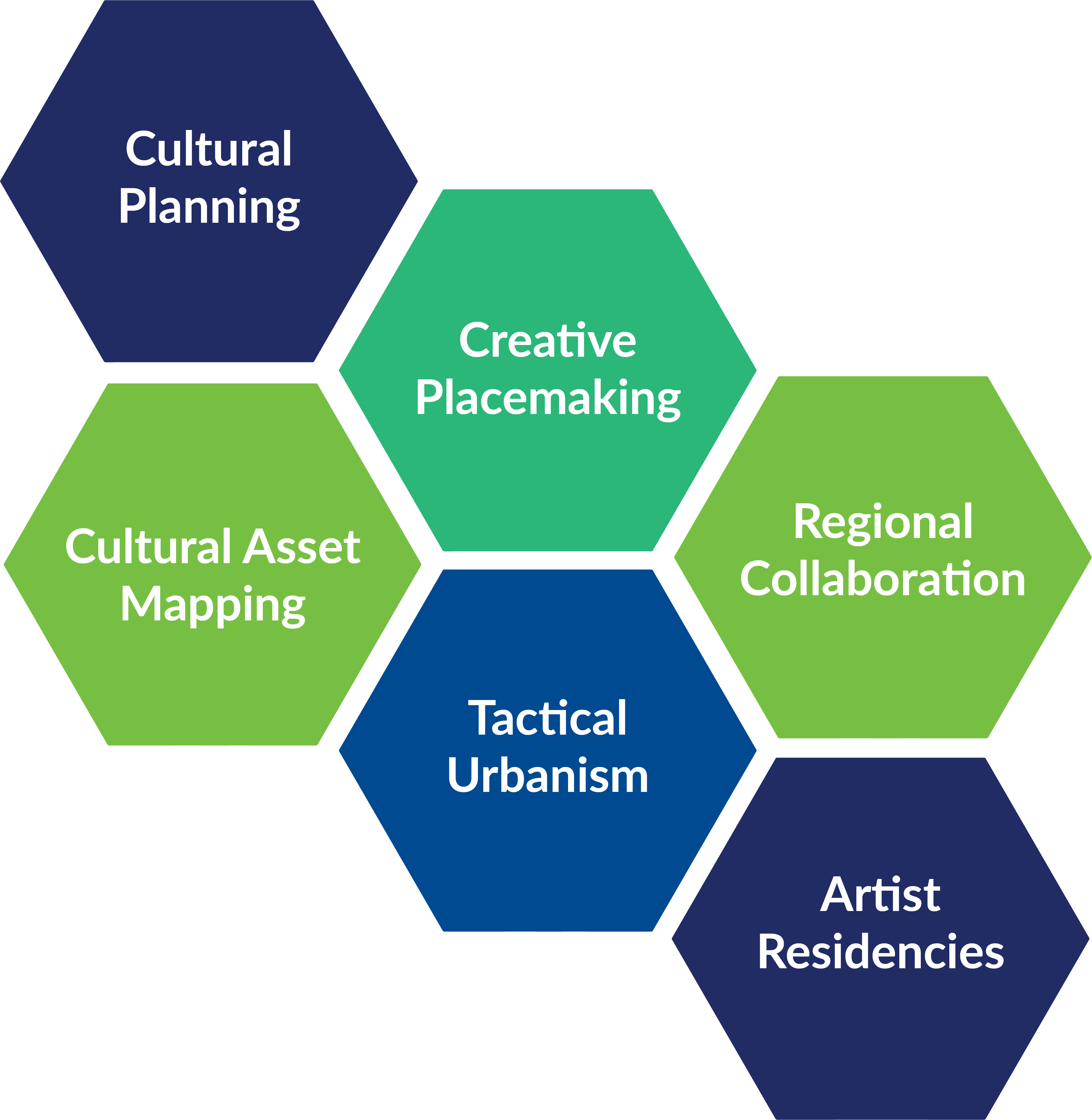Cultural Planning
OVERVIEW
Cultural planning is a place-based planning process that generates a vision and action plan for strengthening and growing arts and culture assets.
Cultural plans may include goals and strategies that address topics including: social cohesion; community engagement; arts and culture programming; services for the creative community; cultural economic development; cultural facilities development; and funding for arts and culture, including permanent or temporary public art and programming.
Why it’s Relevant to Planners
The planning process provides an opportunity for jurisdictions to:
- Expand and enhance artistic and cultural opportunities for the arts/creative community and the broader community
- Strengthen, leverage, and integrate artistic and cultural resources across all facets of local government to creatively advance broader objectives in the areas of economic prosperity, social equity, the environment, and cultural vitality.

CONTEXT
A Brief History of Cultural Planning
Innovations in arts, culture, and planning can be traced back to U.S. traditions and movements that emerged during the late 19th and early 20st centuries. In fact, the origins of the practice of public art, also referred to as civic art, had its origins in the same trends and movements that led to the birth of modern city planning.
In the earlier part of the 19th century, rapid and unregulated development spurred citizen-driven and public sector initiatives in the arenas of municipal art, civic improvement, and outdoor/public art. Some of these initiatives were bottom-up, citizen driven initiatives whereas others were backed by wealthy elites.
Municipal arts movements focused on architectural and public art amenities in public spaces like murals, sculptures, and fountains as a response to perceptions of urban decay. Many public art commissions were established as part of municipal urban planning initiatives surrounding the production of the World's Fairs, which took place in major American cities. Commissions created during this "City Beautiful" movement generated public funding for cultural facilities and innovative architecture for public buildings, which planner Charles Mulford Robinson called "civic art" [which] exists not for its own sake, but mainly for the good of the community. Civic improvement initiatives focused on small-scale beautification efforts on a block-by-block, lot-by-lot basis and led to the creation of entities like the National League of Improvement Associations, which was later renamed the American League for Civic Improvement. City planner Charles Mulford Robinson reported in 1906 that over 2,400 improvement societies had emerged in the U.S. Robinson also authored a book on the topic, Modern Civic Art, which made the case for organizing small-scale improvements into general plans.
PARTNERS
Who Participates in Cultural Planning?
Cultural plans may be created by a municipal employee in the planning department, local arts agency, or by an outside consultant. Either way, the writer of the plan should establish a process that engages local leaders and their communities in generating content for the plan. A successful cultural planning process builds and strengthens relationships between municipal employees in planning departments, departments of public works, public safety, and other departments, and the community members they serve.
FUNDING
Who Funds Cultural Plans?
Cultural plans can be financed directly by the state, municipalities, or Business Improvement Districts. These entities may also apply for funding to finance the production of a cultural plan through operational support or technical assistance.
PROCESS
Types of Cultural Plans
Cultural plans can vary in scope depending on the goals and objectives of the planning process. Cultural plans may be government-led or community-led. Types of cultural plans include:
Defines a broad set of goals and strategies that may align with other defined community needs and opportunities and provides a framework
Regional Examples
City or Town Examples
Jump-to
Learn More
Case Studies
MAPC Projects

SUCCESSES
Components of a Cultural Planning Process
A comprehensive cultural planning process typically includes:
- establishing a leadership team to inform plan development, outreach, and engagement;
- conducting an inventory and assessment of key findings: individuals, organizations, institutions, and other arts and culture assets on public and private land; and
- developing a community vision and action plan, and identifying resources needed to implement the vision.
EXAMPLES
Examples of Cultural Plans
Learn More
The Arts and Planning Interest Group (APIG) is a collaborative space for planners and artists who believe that arts and culture is an essential element of what makes places and communities healthy, connected, and vibrant. APIG provides a forum for identifying, developing, and refining policy and planning tools that promote the integration of arts and culture into community development and planning. Membership is open to non-APA members. Join APIG by completing this survey.
CCNC's Cultural Planning Toolkit is a guide for the process of cultural planning in a community. It includes an adaptable model and practical checklists for navigating and charting progress.
This field scan, commissioned by ArtPlace America, is an inquiry into the state of arts, culture, and creative placemaking as it relates to the public safety sector. Its findings and recommendations draw upon existing literature, an online survey of 100 creative placemaking stakeholders, and semi-structured interviews with the community of artists, thought leaders, investors, and organizations working at this intersection. It also identifies projects at the intersection of creative placemaking and public safety and organizes them into five areas of activity.
References
- Cultural Planning Toolkit. Creative City Network of Canada (2010). http://www.creativecity.ca/database/files/library/cultural_planning_toolkit.pdf
- Municipal Cultural Planning: A Toolkit for Ontario Municipalities (2011). http://www.ontariomcp.ca/toolkits/MunicipalCulturalPlanning_AToolkitForOntarioMunicipalities_digital.pdf